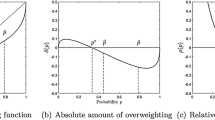Abstract
An insurance model, with realistic assumptions about coverage, deductible and premium, is studied. Insurance is shown to decrease the variance of the cost to the insured, but increase the expected cost, a tradeoff that places our model in the Markowitz mean-variance model.





Similar content being viewed by others
References
Arrow, K. (1974). Optimal insurance and generalized deductibles. Scandinavian Actuarial Journal, 1, 1–42.
Bortoluzzo, A. (2011). Estimating total claim size in the auto insurance industry: a comparison between Tweedie and zero-adjusted inverse Gaussian distribution. BAR, Brazilian Administration Review, Curitiba, 8(1). Available from http://www.scielo.br/scielo.php, access on 09 Dec. 2012.
Casualty Actuarial Society, Enterprise Risk Management Committee (2003). Overview of Enterprise Risk Management, May 2003.
COSO (2004). Enterprise Risk Management-Integrated Framework Executive Summary, Committee of Sponsoring Organizations of the Treadway Commission.
Cummins, J. D., & Mahul, O. (2004). The demand for insurance with an upper limit on coverage. The Journal of Risk and Insurance, 71, 253–264.
Dionne, G. (Ed.) (2000). Handbook of insurance. Boston: Kluwer Academic.
Gollier, C., & Schlesinger, H. (1996). Arrow’s theorem on the optimality of deductibles: A stochastic dominance approach. Economic Theory, 7, 359–363.
Hewitt, C. C. Jr., & Lefkowitz, B. (1979). Methods for fitting distributions to insurance loss data, in Proceedings of the casualty actuarial society, LXVI, pp. 139–160.
Jorgensen, B., & De Souza, M. C. P. (1994). Fitting Tweedie’s compound Poisson model to insurance claims data. Scandinavian Actuarial Journal, 69–93.
Machina, M. J. (1995). Non-expected utility and the robustness of the classical insurance paradigm. The Geneva Papers on Risk and Insurance Theory, 20, 9–50.
Markowitz, H. M. (1952). Portfolio selection. The Journal of Finance, 7, 77–91.
Markowitz, H. M. (1959). Portfolio selection: efficient diversification of investments. New York: Wiley.
New Jersey Auto Insurance Buyer’s Guide A-705(4/10) (2011)
Olson, D. L., & Wu, D. (2010). Enterprise risk management models. Berlin: Springer.
Pashigian, B. P., Schkade, L. L., & Menefee, G. H. (1966). The selection of an optimal deductible for a given insurance policy. The Journal of Business, 39, 35–44.
Raviv, A. (1979). The design of an optimal insurance policy. The American Economic Review, 69, 84–96.
Schlesinger, H. (1981). The optimal level of deductibility in insurance contracts. The Journal of Risk and Insurance, 48, 465–481.
Schlesinger, H. (1997). Insurance demand without the expected–utility paradigm. The Journal of Risk and Insurance, 64, 19–39.
Smith, V. (1968). Optimal insurance coverage. Journal of Political Economy, 76, 68–77.
Smyth, G. K., & Jorgensen, B. (2002). Fitting Tweedie’s compound Poisson model to insurance claims data: dispersion modeling. ASTIN Bulletin, 32, 143–157.
Wu, D., Olson, D., & Birge, J. (2011). Introduction to special issue on “Enterprise risk management in operations”. International Journal of Production Economics, 134, 1–2.
Zhou, C., Wu, W., & Wu, C. (2010). Optimal insurance in the presence of insurer’s loss limit. Insurance. Mathematics & Economics, 46, 300–307.
Author information
Authors and Affiliations
Corresponding author
Appendix: Proof of Theorem 1
Appendix: Proof of Theorem 1
We prove (42)
given that (22) holds,
which implies that either
or
hold.
From (39),
and
By (41) the partial derivative of \(\operatorname {Var}L(\mathbf{X})\) w.r.t. C is
We calculate next the three derivatives on the right side.
-
(a)
Clearly,
$$ \frac{\partial}{\partial C}\operatorname{Var}\mathbf{X}=0. $$(55) -
(b)
$$\begin{aligned} \frac{\partial}{\partial C}\operatorname{Var}\phi(\mathbf {X})&=(2C-2D) \int _C^\infty f(x) \,dx+2 \int_D^C (D-x)f(x) \,dx \int_C^\infty f(x) \,dx \\ &\quad -2(C-D) \biggl(\int_C^\infty f(x) \,dx \biggr)^2 \\ &=2 \int_C^\infty f(x) \,dx \biggl[C \int _0^C f(x) \,dx \\ &\quad -D \int_0^D f(x) \,dx-\int_D^C xf(x) \,dx \biggr] \end{aligned}$$(56)
-
(c)
From (39),
$$\begin{aligned} \operatorname{E} \bigl(\mathbf{X}\phi(\mathbf{X})\bigr) - \operatorname {E} \mathbf{X}\operatorname{E} \phi(\mathbf{X}) &= D \biggl[\int_D^\infty x f(x) \,dx - (\operatorname{E} \mathbf{X}) \int_D^\infty f(x) \,dx \biggr] \\ &\quad -C \biggl[\int_C^\infty x f(x) \,dx - ( \operatorname{E} \mathbf {X}) \int_C^\infty f(x) \,dx \biggr] \\ &\quad - \biggl[\int_D^C x^2 f(x)\,dx-( \operatorname{E} \mathbf{X}) \int_D^Cx f(x) \,dx \biggr]. \end{aligned}$$
Therefore
Substituting (55), (56), and (57) in (54) we get
Rearrange (58) to get
The right side of (59) can be written as
Similarly, (60) is negative if (51) holds, because then
This completes the proof of (42) if any of the conditions (50)–(51) holds.
The inequality (43) is similarly proved.
Rights and permissions
About this article
Cite this article
Gaffney, C., Ben-Israel, A. A simple insurance model: optimal coverage and deductible. Ann Oper Res 237, 263–279 (2016). https://doi.org/10.1007/s10479-013-1469-2
Published:
Issue Date:
DOI: https://doi.org/10.1007/s10479-013-1469-2



